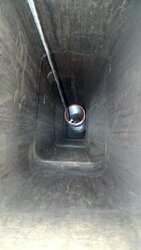I'm planning a Stainless Steel liner install for a used insert I bought, but like everything I try to do, nothing’s ever easy. Our house has a 3 pot chimney (basement fireplace, living room fireplace, and furnace). I’m installing the insert in our basement fireplace, which is a problem since the chimney is not straight, and it’s not 11 x 11” clay tiles. Our chimney sweep said the basement fireplace is below the one in living room, so the basement fireplace chimney goes up, makes a turn (about 30 degrees) and then makes another turn before going up to the top, and the next problem is the clay liners only have a 6.5 x 10” opening. The chimney sweep let me borrow some leftover 5.5 and 6” pipe he had from installs he’d done. I tried the 5.5” first and it goes down fine, but won’t make the first turn going down. I had my wife tug on the rope running into the fireplace, but we didn’t want to get the liner stuck in there, so we didn’t really pull too hard on it. Does anyone know if a round liner will work with this chimney, or have any other ideas for me?
This is a view looking down the chimney (there was another rope attached to the bottom running into the fireplace).

This is a view looking down the chimney (there was another rope attached to the bottom running into the fireplace).

Last edited by a moderator:

